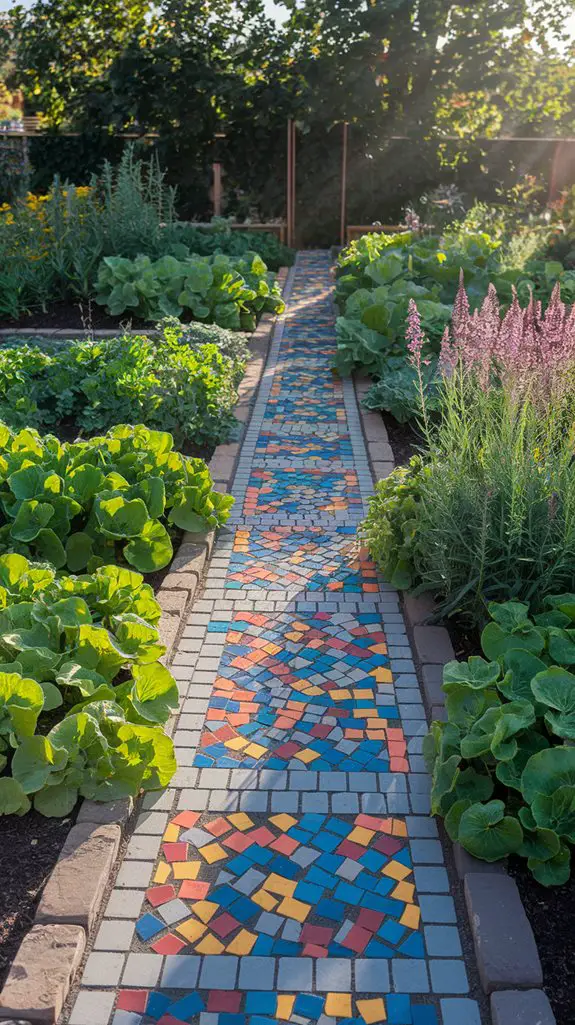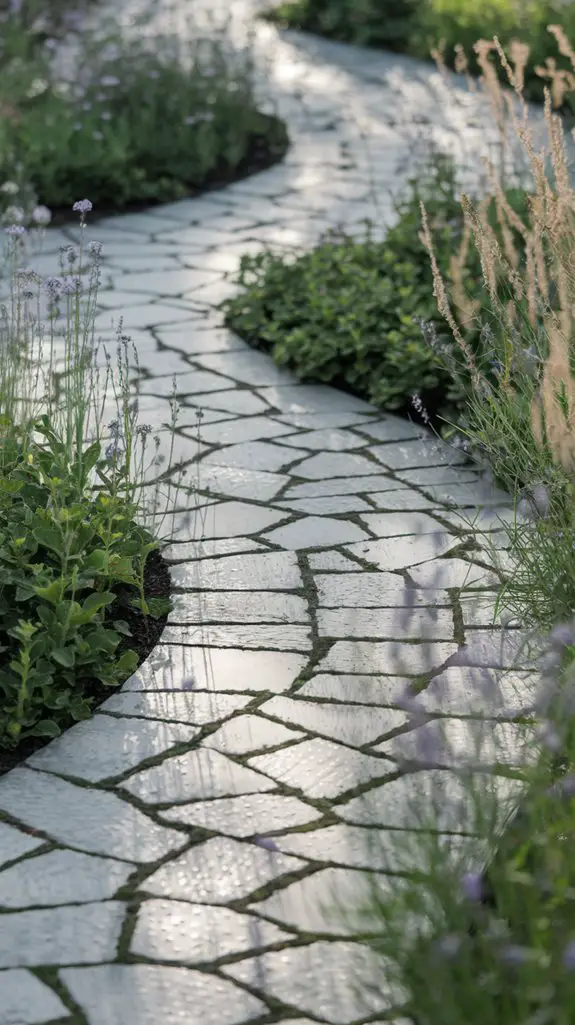Nearly 75% of garden materials discarded during landscaping projects could be repurposed into sustainable path features. You’ll find that creating garden pathways from recycled materials not only reduces waste but also adds character and ecological value to your outdoor space. By transforming broken concrete, salvaged bricks, or reclaimed wood into functional walkways, you’re making an environmentally conscious choice while potentially saving hundreds on landscaping costs. The techniques for turning these cast-offs into durable, attractive paths aren’t as complex as you might think.
The Environmental Benefits of Recycled Garden Paths
When you construct garden paths using recycled materials, you’re making a significant contribution to environmental conservation through several key mechanisms.
By repurposing materials like broken concrete, salvaged brick, or reclaimed wood, you’re diverting waste from landfills while reducing demand for newly manufactured products.
These choices dramatically decrease your carbon footprint by eliminating the energy-intensive extraction and processing of virgin materials. The embodied energy—total energy consumed during a product’s lifecycle—is substantially lower in recycled materials.
Additionally, you’re preventing the release of methane that occurs when organic materials decompose in landfills.
Local sourcing of recycled materials further reduces transportation emissions.
Over time, your sustainable paths will integrate with the surrounding ecosystem, creating microclimates that support beneficial insects and enhance soil health through improved drainage patterns. Furthermore, using eco-friendly materials can contribute to a healthier garden environment that promotes biodiversity.
Assessing Your Garden Space Before Starting Your Path

While environmental considerations shape your material choices, proper spatial assessment forms the foundation of any successful garden path project.
Begin by mapping your garden’s traffic patterns, identifying natural walking routes that family members already follow. Measure the dimensions needed—paths should be at least 30 inches wide for single-file walking, and 48 inches for side-by-side passage.
Analyze your soil type and drainage conditions, as these factors will determine what base materials you’ll need. Clay soils require more extensive drainage solutions than sandy soils.
Document sun exposure patterns throughout the day, as this affects both material durability and plant integration alongside your path.
Finally, note any elevation changes requiring steps or gentle grades. These measurements and observations will inform your material quantities, path layout, and construction techniques. Additionally, consider incorporating low-maintenance designs that can enhance your garden’s aesthetic while saving you time.
Broken Concrete and Urbanite Pathway Designs

Reclaimed concrete, often called “urbanite,” represents one of the most sustainable materials for garden path construction. This zero-cost resource transforms demolition waste into an attractive, durable pathway solution.
Break concrete slabs into manageable pieces, typically 2-4 inches thick, with irregular edges creating visual interest.
Arrange urbanite pieces with 1/2 to 2-inch gaps between them, positioning flat sides up for comfortable foot traffic. Fill interstices with drought-tolerant groundcover, crushed gravel, or decomposed granite to prevent weed growth.
For stability, excavate 4-6 inches below grade, add a 2-inch sand base, then set your concrete pieces atop it.
You’ll need basic tools: shovel, wheelbarrow, hammer, chisel, and safety glasses.
Consider adding iron oxide pigment to exposed edges for weathered, rustic aesthetics that blend with your landscape’s color palette. Additionally, using eco-friendly options for pathways can further enhance the sustainability of your garden design.
Creating Stable Paths With Reclaimed Brick and Stone
Beyond urbanite, salvaged brick and stone offer exceptional options for sustainable pathway construction. These materials provide durability while reducing environmental impact through reuse. When sourcing reclaimed materials, inspect for structural integrity and consistent dimensions to guarantee proper installation. Using recycled materials for sustainable gardening can also enhance the ecological benefits of your outdoor spaces.
| Material Type | Installation Method | Base Depth | Jointing Material | Durability |
|---|---|---|---|---|
| Clay Brick | Dry-set | 4-6 inches | Sand | 25+ years |
| Cobblestone | Mortared | 6-8 inches | Lime mortar | 50+ years |
| Flagstone | Sand-set | 4-6 inches | Polymeric sand | 30+ years |
| Granite Pavers | Dry-set | 6-8 inches | Decomposed granite | 100+ years |
| Limestone | Mortared | 4-6 inches | Type S mortar | 20-30 years |
Prepare a compacted sub-base of crushed stone before laying your reclaimed materials. For ideal drainage, establish a 1-2% slope away from structures and consider permeable jointing materials.
Glass Bottle Bases and Mosaic Path Techniques
Glass bottle bases and mosaic installations represent innovative approaches to sustainable path creation that combine artistic expression with environmental responsibility. When embedded in concrete or mortar, bottles create striking light-filtering elements while diverting waste from landfills. Not only do these designs add beauty, but they also incorporate artistic garden pathway ideas that inspire creativity in your landscaping.
- Prep bottles by removing labels, cleaning thoroughly, and breaking off necks (wear protective equipment) or use intact bases positioned upside-down.
- Arrange bottles in desired pattern within wooden forms, maintaining 2-3″ spacing for structural integrity.
- Mix mortar with recycled aggregate at 3:1 ratio (aggregate:cement), pour to 4″ depth, vibrate to eliminate air pockets.
- For mosaics, use broken ceramic tiles, glass fragments, or stone pieces pressed into a 1″ wet mortar bed, sealing with eco-friendly sealant after 48-hour curing.
Wood Pallet and Reclaimed Timber Walkways
While glass elements create visually striking pathways, wood-based materials offer organic warmth and structural versatility for sustainable garden paths. Rustic backyard garden pathway options can further enhance the charm and appeal of your outdoor space.
Reclaimed pallets provide an abundant source of pre-cut timber that you’ll find easy to disassemble and repurpose. Select hardwood pallets when possible, as they’ll resist rot and insect damage longer than softwood varieties.
For installation, lay a geotextile fabric base to prevent weed growth, then arrange pallet boards in a staggered pattern atop a 2-inch gravel bed for drainage.
Secure using galvanized screws or recycled rebar stakes. Weather-resistant finishes like tung oil or beeswax extend longevity without ecological harm, while borax treatments deter pests naturally.
When sourcing reclaimed timber, inspect thoroughly for chemical treatments—avoid CCA-treated wood that contains arsenic compounds dangerous to garden ecosystems.
Recycled Rubber and Tire Pathways for Wet Areas
Although moisture often creates slippery conditions on traditional pathways, recycled rubber and tire materials offer exceptional traction and durability in garden areas prone to flooding or persistent dampness.
These materials drain efficiently while providing a stable surface that won’t deteriorate when exposed to constant moisture.
- Preparation: Create a 4-inch base of crushed stone for drainage before installing rubber pavers or tire mulch.
- Edging options: Install aluminum, steel, or recycled plastic borders to contain rubber materials and prevent migration.
- Thickness requirements: Apply rubber mulch at 2-3 inches for ideal performance in high-traffic wet zones.
- Maintenance protocol: Rinse pathways quarterly with diluted vinegar solution (1:10 ratio) to prevent algae formation.
You’ll find these pathways remain functional year-round without developing the mold or rot common to organic materials in damp environments.
Maintenance Tips for Long-Lasting Sustainable Paths
Even the most expertly constructed sustainable garden paths require consistent maintenance to preserve their functionality and appearance over decades. Apply these seasonal techniques to extend your path’s lifespan:
| Season | Maintenance Task | Benefits |
|---|---|---|
| Spring | Remove debris, replace displaced materials | Prevents weed growth, maintains level surface |
| Summer | Pressure wash stone/pavers, reapply sand | Removes algae, stabilizes materials |
| Fall | Seal wooden elements, clear drainage channels | Prevents rot, avoids water damage |
Inspect your paths quarterly for signs of settling or erosion. Immediately address loose elements before they compromise structural integrity. For paths constructed with recycled materials, verify connections between dissimilar materials annually, as expansion rates differ. Consider applying environmentally-friendly sealants to permeable materials every two years to maintain water management properties while preventing decomposition. Additionally, implementing crop rotation techniques can enhance soil health, which is crucial for the longevity of nearby garden paths.
Budget-Friendly Material Sourcing and Collection Methods
Creating sustainable garden paths doesn’t have to strain your budget when you know where to find affordable or free materials.
Resourceful gardeners can acquire quality path-building components through strategic sourcing and community connections.
- Contact local construction sites for discarded bricks, tiles, or stone pieces that would otherwise be landfill-bound; many contractors will donate these materials to avoid disposal fees.
- Establish relationships with tree services to secure wood chips or logs from their regular trimming operations.
- Monitor online marketplace platforms like Freecycle, Facebook Marketplace, or Craigslist where homeowners frequently offer leftover pavers and landscaping materials.
- Explore municipal recycling centers that separate construction debris and may allow residential collection at minimal cost.
In addition, consider incorporating charming outdoor seating ideas into your garden design to enhance the overall aesthetic and functionality of your space.
Conclusion
Your sustainable garden path is more than a walkway—it’s a tribute to environmental stewardship. By implementing recycled materials with proper drainage and substructure techniques, you’ll create a path that stands the test of time while treading lightly on the planet. Remember to maintain your creation with eco-friendly practices, and you’ll enjoy the fruits of your labor for years to come as your garden’s sustainable backbone flourishes.




